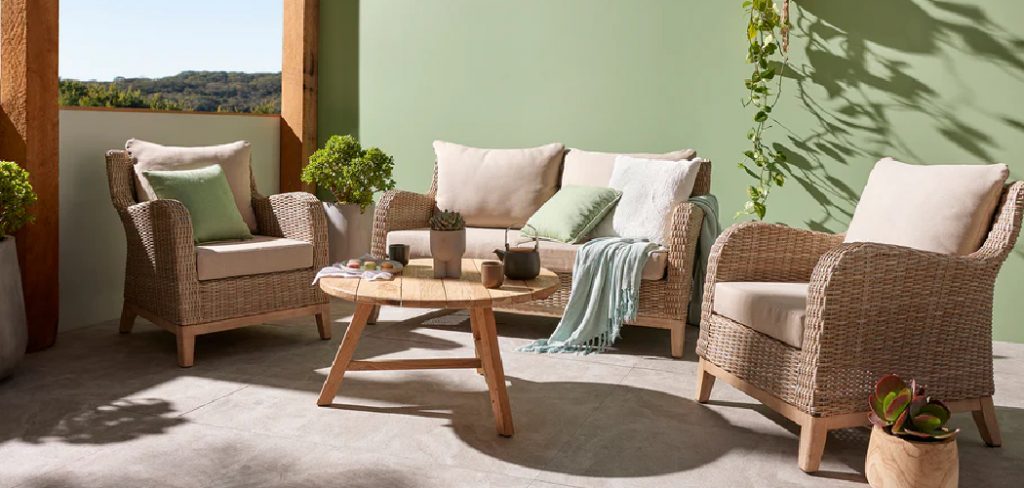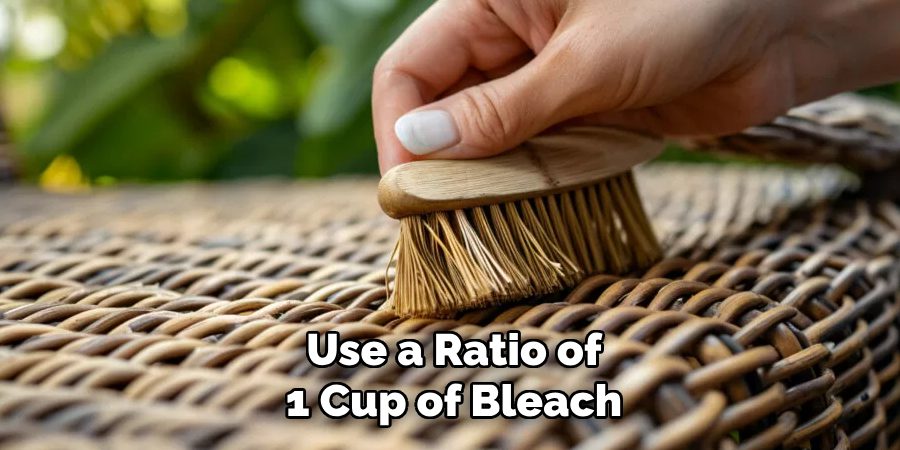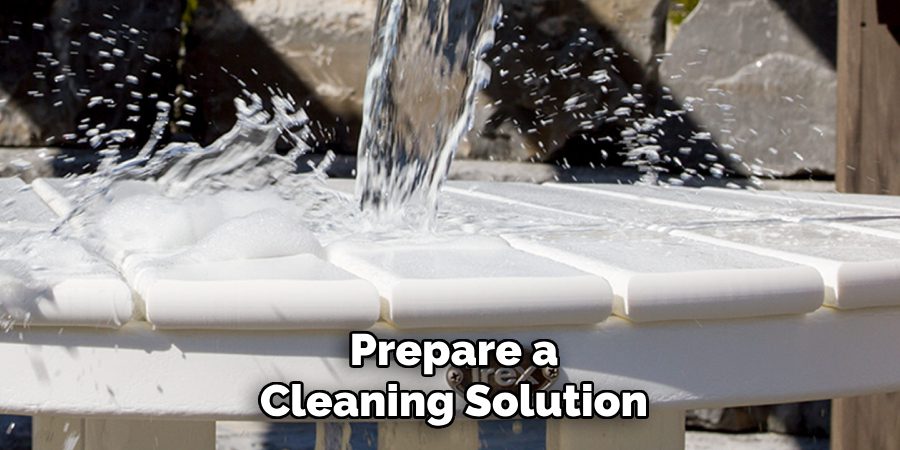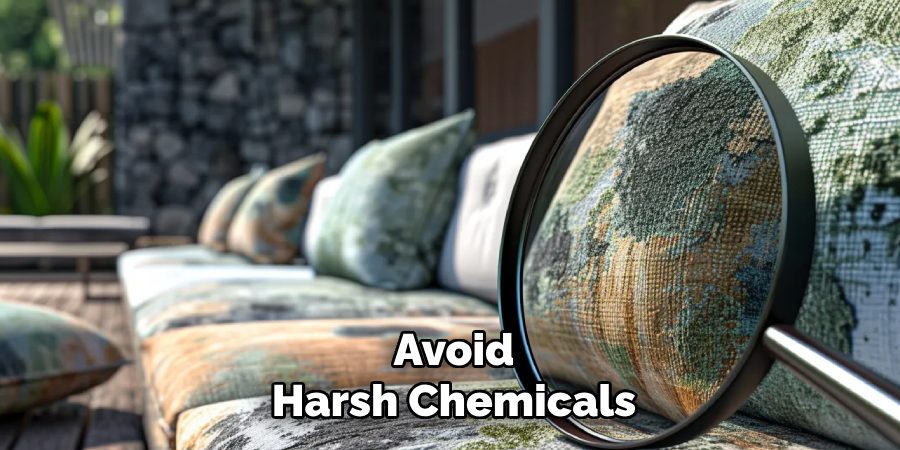Are you tired of seeing mildew on your patio furniture? Do you want to learn how to effectively clean it off and keep it from returning? If so, then this guide is for you!

Keeping patio furniture clean and mildew-free is essential to maintaining its appearance and longevity. Mildew, a common issue in outdoor spaces, thrives in damp and humid conditions, leaving unsightly stains and unpleasant odors on your furniture.
Fortunately, removing mildew is a straightforward process that doesn’t require extensive effort or harsh chemicals. With the right tools and techniques, you can restore your patio furniture to its original condition and ensure it stays fresh and inviting for years.
This guide on how to clean mildew off patio furniture will walk you through the steps to effectively clean mildew off your outdoor furniture.
What Are the Benefits of Cleaning Mildew Off Patio Furniture?
Aside from improving the appearance of your patio furniture, there are several benefits to keeping it free of mildew. These include:
- Preventing Damage: Mildew can cause discoloration and deterioration of your furniture’s fabric or surface.
- Avoiding Health Risks: Mold and mildew can trigger allergies and respiratory issues in some people.
- Prolonging Lifespan: Regular cleaning can help extend the life of your patio furniture by preventing mildew from breaking down its materials.
These benefits contribute to the aesthetic appeal of your outdoor space and help protect your investment in quality patio furniture.
What Will You Need?
Before you begin cleaning, gather the following items:
- Bleach: This strong disinfectant effectively kills mildew and prevents its regrowth.
- Water: You will need water to mix with bleach and rinse off your furniture.
- Dish Soap: A gentle dish soap can help remove dirt or grime build-up on your furniture.
- Bucket or Spray Bottle: Choose whichever tool is most convenient for you to mix and apply the cleaning solution.
- Scrub Brush or Sponge: These tools will help you remove the mildew from your furniture’s surface.
- Gloves: Protect your hands from harsh chemicals and bacteria by wearing gloves.
- Protective Eyewear: Keep your eyes safe from splashes or fumes while cleaning.
- Old Towels or Rags: Have a few old towels or rags on hand to dry off your furniture after cleaning.
8 Easy Steps on How to Clean Mildew Off Patio Furniture
Step 1: Prepare Your Cleaning Solution
Begin by creating a mixture of bleach and water, serving as your cleaning solution. Use a ratio of 1 cup of bleach to every gallon of water. This balance ensures the solution is strong enough to eliminate mildew without causing unnecessary damage to your furniture. If you’d prefer a more natural approach, you can mix a solution using white vinegar instead of bleach—combine equal parts vinegar and water for an effective alternative.
Once you have chosen your cleaning method, pour the mixture into a bucket or spray bottle, depending on what is most convenient for you. Make sure to mix the solution thoroughly to distribute the ingredients evenly. Always work in a well-ventilated area to avoid inhaling fumes, and remember to wear your gloves and protective eyewear before handling the solution for added safety.
Step 2: Apply the Cleaning Solution
Carefully apply the cleaning solution to the affected areas of your patio furniture. If you’re using a spray bottle, liberally spray the solution over the mildew spots, ensuring complete coverage. For a bucket application, use a sponge or soft-bristle brush to soak up the solution and gently scrub the affected areas.

Work methodically, focusing on one section at a time to ensure the solution has time to penetrate and break down the mildew. Avoid using abrasive materials that could damage the surface of your furniture. Allow the solution to sit for 10-15 minutes to effectively loosen the mildew before moving on to the next step.
Step 3: Rinse Thoroughly
Once the cleaning solution has had ample time to work, rinse the furniture thoroughly with clean water. Use a hose or a bucket of water to wash away the solution and loosen mildew. Remove all traces of the cleaning solution, as residual chemicals could damage the surface or attract dirt over time.
Consider using a clean sponge or cloth to assist with rinsing for intricate or hard-to-reach areas. Inspect your furniture as you rinse to ensure all mildew is gone. Repeat the cleaning process if necessary for stubborn spots.
Step 4: Dry Properly
After rinsing, it’s crucial to dry your furniture thoroughly to prevent the recurrence of mildew. Use a clean, dry cloth or towel to wipe down all surfaces, paying attention to any crevices or joints where water might collect. For larger pieces, allow them to air dry in a well-ventilated area or under direct sunlight, which can help deter mildew growth. Avoid covering or storing the furniture until it is completely dry, as trapped moisture can create the ideal environment for mildew to return.
Step 5: Apply Protective Measures
Consider applying a protective treatment to prolong your furniture’s life and prevent future mildew growth. Use a sealant or protective oil designed to repel moisture for wooden furniture. Treat fabric or upholstered items with a fabric protector spray that helps resist water and stains.

Regularly cleaning and inspecting your furniture for early signs of mildew or wear can also help maintain its condition. Store your furniture in a dry and well-ventilated space when not in use to further reduce the risk of mildew development.
Step 6: Regular Maintenance
Regular upkeep is essential to keep your furniture free from mildew and in excellent condition. Establish a routine for cleaning your furniture, tailored to its material type, at least every few months. Dust or wipe down surfaces regularly to prevent the accumulation of dirt and moisture, which can lead to mildew.
Protect outdoor furniture during adverse weather conditions by using covers or moving it to a sheltered area. Consistent maintenance not only preserves the appearance of your furniture but also extends its durability over time.
Step 7: Handling Severe Mildew Issues
If your furniture already has significant mildew growth, it must address the issue promptly to prevent further damage. Begin by taking the furniture outdoors to avoid spreading spores inside your home. Use a soft brush to remove as much of the mildew as possible gently.
Prepare a cleaning solution appropriate for the material, such as a mild soap, warm water mixture, or a dedicated mildew cleaner. Test the solution on a small, inconspicuous area to ensure it won’t damage the surface. Scrub the affected areas thoroughly, then rinse with clean water and let the furniture dry thoroughly in a well-ventilated area. Consider consulting a professional cleaning service to restore your furniture safely and effectively for persistent mildew.

Step 8: Protecting Your Furniture from Future Mildew Growth
To minimize the chances of mildew returning, it’s essential to take preventative measures. Store your furniture in a dry, well-ventilated area with low humidity. Consider using dehumidifiers or moisture-absorbing products in storage spaces to control humidity levels.
Regularly inspect your furniture for early signs of mildew and clean it promptly to prevent buildup. Additionally, applying protective sprays or finishes designed for your furniture’s material can create a barrier against moisture and fungal growth, ensuring your pieces remain in top condition for years.
By following these steps and taking care of your furniture, you can enjoy a clean and mildew-free outdoor space all year round.
5 Things You Should Avoid
1. Using Harsh Chemicals: Avoid harsh chemicals like bleach or ammonia unless necessary. These can damage your furniture’s material, discolor fabrics, or even harm the surrounding environment.

2. Skipping a Patch Test: Never skip testing your cleaning solution on a small, inconspicuous area first. Some cleaners may cause unexpected reactions to specific materials, leading to permanent damage.
3. Allowing Mildew to Stay Too Long: Do not delay addressing mildew growth, as it can lead to deeper stains, odors, and irreversible damage. Prompt cleaning ensures easier removal and protects your furniture’s longevity.
4. Using Excessive Water: Avoid using too much water during cleaning. Excess water can soak through certain materials, contributing to mold growth and structural damage over time.
5. Scrubbing Aggressively: Refrain from scrubbing too aggressively, especially if your furniture is made from delicate materials. This can cause scratches, tears, or a weakened surface, leaving your furniture looking worn.
By avoiding these common cleaning mistakes, you can preserve the quality and appearance of your furniture for years to come.
Conclusion
How to clean mildew off patio furniture doesn’t have to be a daunting task when approached systematically and with the right tools.
Start by gently brushing away loose mildew with a soft brush, ensuring that the spores do not spread. Then, prepare a cleaning solution of mild detergent mixed with water or a vinegar solution for more stubborn cases. Apply the mixture to the affected areas and allow it to sit for a few minutes before gently scrubbing with a sponge or soft-bristle brush. Rinse thoroughly with clean water and let the furniture air dry thoroughly, preferably in direct sunlight.
Regular upkeep and prompt action can prevent mildew, keeping your patio furniture fresh and ready for outdoor enjoyment.

Professional Focus
Oliver Wood, a passionate patio designer, specializes in creating comfortable and inviting outdoor spaces that enhance relaxation and entertainment. His work combines a deep understanding of design with a love for nature, making him a standout professional in the field of outdoor living spaces. Through his thoughtful approach, he transforms everyday patios into extraordinary retreats for family and friends.
About the Author
Oliver Wood, a skilled patio designer, shares his expertise on outdoor living through his designs and insights. With a background in patio design and a genuine passion for creating beautiful spaces, he encourages others to invest in their outdoor environments, enhancing their homes with functional and inviting spaces for relaxation and entertainment.
Education History
University: Virginia Union University
Oliver’s education equipped him with the knowledge and skills to design patios that merge aesthetics with comfort, transforming outdoor areas into beautiful extensions of the home.
Expertise:
- Patio Design and Outdoor Living Spaces
- Functional and Aesthetic Landscaping
- Comfortable and Inviting Outdoor Environments
- Design Philosophy for Family-Oriented Spaces
- Creating Spaces for Relaxation and Entertainment
